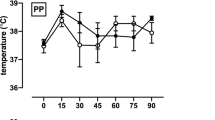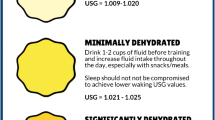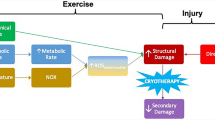Abstract
Cooling strategies that help prevent a reduction in exercise capacity whilst exercising in the heat have received considerable research interest over the past 3 decades, especially in the lead up to a relatively hot Olympic and Paralympic Games. Progressing into the next Olympic/Paralympic cycle, the host, Rio de Janeiro, could again present an environmental challenge for competing athletes. Despite the interest and vast array of research into cooling strategies for the able-bodied athlete, less is known regarding the application of these cooling strategies in the thermoregulatory impaired spinal cord injured (SCI) athletic population. Individuals with a spinal cord injury (SCI) have a reduced afferent input to the thermoregulatory centre and a loss of both sweating capacity and vasomotor control below the level of the spinal cord lesion. The magnitude of this thermoregulatory impairment is proportional to the level of the lesion. For instance, individuals with high-level lesions (tetraplegia) are at a greater risk of heat illness than individuals with lower-level lesions (paraplegia) at a given exercise intensity. Therefore, cooling strategies may be highly beneficial in this population group, even in moderate ambient conditions (~21 °C). This review was undertaken to examine the scientific literature that addresses the application of cooling strategies in individuals with an SCI. Each method is discussed in regards to the practical issues associated with the method and the potential underlying mechanism. For instance, site-specific cooling would be more suitable for an athlete with an SCI than whole body water immersion, due to the practical difficulties of administering this method in this population group. From the studies reviewed, wearing an ice vest during intermittent sprint exercise has been shown to decrease thermal strain and improve performance. These garments have also been shown to be effective during exercise in the able-bodied. Drawing on additional findings from the able-bodied literature, the combination of methods used prior to and during exercise and/or during rest periods/half-time may increase the effectiveness of a strategy. However, due to the paucity of research involving athletes with an SCI, it is difficult to establish an optimal cooling strategy. Future studies are needed to ensure that research outcomes can be translated into meaningful performance enhancements by investigating cooling strategies under the constraints of actual competition. Cooling strategies that meet the demands of intermittent wheelchair sports need to be identified, with particular attention to the logistics of the sport.

Similar content being viewed by others
References
Galloway SD, Maughan RJ. Effects of ambient temperature on the capacity to perform prolonged cycle exercise in man. Med Sci Sports Exerc. 1997;29(9):1240–9.
Nielsen B. Olympics in Atlanta: a fight against physics. Med Sci Sports Exerc. 1996;28(6):665–8.
Borresen J. Environmental considerations for athletic performance at the 2008 Beijing Olympic Games. Int Sport Med J. 2008;9(2):44–55.
INMET. Rio 2016. Climate information (online). http://www.rio2016.com/pregamestraining/en/climate-information/rio-de-janeiro. Accessed 10 Jun 2013.
Freund PR, Brengelmann GL, Rowell LB, et al. Attenuated skin blood flow response to hyperthermia in paraplegic men. J Appl Physiol. 1984;56(4):1104–9.
Rawson RO, Hardy JD. Sweat inhibition by cutaneous cooling in normal sympathectomized and paraplegic man. J Appl Physiol. 1967;22(2):287–91.
Tam HS, Darling RC, Cheh HY, et al. Sweating response: a means of evaluating the set-point theory during exercise. J Appl Physiol. 1978;45(3):451–8.
Hopman MT. Circulatory responses during arm exercise in individuals with paraplegia. Int J Sports Med. 1994;15(3):126–31.
Normell LA. Distribution of impaired cutaneous vasomotor and sudomotor function in paraplegic man. Scand J Clin Lab Invest Suppl. 1974;138:25–41.
Price MJ. Thermoregulation during exercise in individuals with spinal cord injuries. Sports Med. 2006;36(10):863–79.
Price MJ, Campbell IG. Thermoregulatory responses of spinal cord injured and able-bodied athletes to prolonged upper body exercise and recovery. Spinal Cord. 1999;37(11):772–9.
Price MJ, Campbell IG. Thermoregulatory responses of paraplegic and able-bodied athletes at rest and during prolonged upper body exercise and passive recovery. Eur J Appl Physiol Occup Physiol. 1997;76(6):552–60.
Hopman MTE, Binkhorst RA. Heat balance during exercise in a hot and cold environment in spinal cord injured individuals. In: van der Woude LHV, Hopman MTE, van Kemenade CH, editors. Biomedical aspects of wheelchair propulsion: the state of the art II. Amsterdam: IOS Press; 1998. p. 333–5.
Guttmann L, Silver J, Wyndham CH. Thermoregulation in spinal man. J Physiol. 1958;142(3):406–19.
Price MJ, Campbell IG. Effects of spinal cord lesion level upon thermoregulation during exercise in the heat. Med Sci Sports Exerc. 2003;35(7):1100–7.
Ross ML, Garvican LA, Jeacocke NA, et al. Novel precooling strategy enhances time trial cycling in the heat. Med Sci Sports Exerc. 2011;43(1):123–33.
Siegel R, Mate J, Brearley MB, et al. Ice slurry ingestion increases core temperature capacity and running time in the heat. Med Sci Sports Exerc. 2010;42(4):717–25.
Lee DT, Haymes EM. Exercise duration and thermoregulatory responses after whole body precooling. J Appl Physiol. 1995;79(6):1971–6.
Olschewski H, Bruck K. Thermoregulatory, cardiovascular, and muscular factors related to exercise after precooling. J Appl Physiol. 1988;64(2):803–11.
Arngrimsson SA, Petitt DS, Stueck MG, et al. Cooling vest worn during active warm-up improves 5-km run performance in the heat. J Appl Physiol. 2004;96(5):1867–74.
Duffield R, Dawson B, Bishop D, et al. Effect of wearing an ice cooling jacket on repeat sprint performance in warm/humid conditions. Br J Sports Med. 2003;37(2):164–9.
Duffield R, Marino FE. Effects of pre-cooling procedures on intermittent-sprint exercise performance in warm conditions. Eur J Appl Physiol. 2007;100(6):727–35.
Booth J, Marino F, Ward JJ. Improved running performance in hot humid conditions following whole body precooling. Med Sci Sports Exerc. 1997;29(7):943–9.
Booth J, Wilsmore BR, Macdonald AD, et al. Whole-body pre-cooling does not alter human muscle metabolism during sub-maximal exercise in the heat. Eur J Appl Physiol. 2001;84(6):587–90.
Kay D, Taaffe DR, Marino FE. Whole-body pre-cooling and heat storage during self-paced cycling performance in warm humid conditions. J Sports Sci. 1999;17(12):937–44.
Grahn DAD, Murray JVJ, Heller HCH. Cooling via one hand improves physical performance in heat-sensitive individuals with multiple sclerosis: a preliminary study. BMC Neurol. 2008;8:14.
House JR, Holmes C, Allsopp AJ. Prevention of heat strain by immersing the hands and forearms in water. J R Nav Med Serv. 1997;83(1):26–30.
Barwood MJ, Davey S, House JR, et al. Post-exercise cooling techniques in hot, humid conditions. Eur J Appl Physiol. 2009;107(4):385–96.
Quod MJ, Martin DT, Laursen PB, et al. Practical precooling: effect on cycling time trial performance in warm conditions. J Sports Sci. 2008;26(14):1477–87.
Bongers CC, Thijssen DH, Veltmeijer MT, et al. Precooling and percooling (cooling during exercise) both improve performance in the heat: a meta-analytical review. Br J Sports Med. doi:10.1136/bjsports-2013-092928.
Tyler CJ, Sunderland C, Cheung SS. The effect of cooling prior to and during exercise on exercise performance and capacity in the heat: a meta-analysis. Br J Sports Med. doi:10.1136/bjsports-2012-091739.
Cheung SS. Advanced environmental exercise physiology. Champaign: Human Kinetics; 2010.
Livingstone SD, Nolan RW, Cattroll SW. Heat loss caused by immersing the hands in water. Aviat Space Environ Med. 1989;60(12):1166–71.
Livingstone SD, Nolan RW, Keefe AA. Heat loss caused by cooling the feet. Aviat Space Environ Med. 1995;66(3):232–7.
Ross M, Abbiss C, Laursen P, et al. Precooling methods and their effects on athletic performance : a systematic review and practical applications. Sports Med. 2013;43(3):207–25.
Goosey-Tolfrey V, Swainson M, Boyd C, et al. The effectiveness of hand cooling at reducing exercise-induced hyperthermia and improving distance-race performance in wheelchair and able-bodied athletes. J Appl Physiol. 2008;105(1):37–43.
Hagobian TA, Jacobs KA, Kiratli BJ, et al. Foot cooling reduces exercise-induced hyperthermia in men with spinal cord injury. Med Sci Sports Exerc. 2004;36(3):411–7.
Mora-Rodriguez R. Influence of aerobic fitness on thermoregulation during exercise in the heat. Exerc Sport Sci Rev. 2012;40(2):79–87.
Pritchett RC, Bishop PA, Yang Z, et al. Evaluation of artificial sweat in athletes with spinal cord injuries. Eur J Appl Physiol. 2010;109(1):125–31.
Kume M, Yoshida T, Tsuneoka H, et al. Relationship between body surface cooling area, cooling capacity, and thermoregulatory responses wearing water purfused suits during exercise in humans. Jpn J Phys Fit Sports Med. 2009;58(1):109–21.
Young AJ, Sawka MN, Epstein Y, et al. Cooling different body surfaces during upper and lower body exercise. J Appl Physiol. 1987;63(3):1218–23.
Price M, Campbell I. Thermoregulatory and physiological responses of wheelchair athletes to prolonged arm crank and wheelchair exercise. Int J Sports Med. 1999;20(7):457–63.
American College of Sports Medicine, Armstrong LE, Casa DJ, et al. American college of sports medicine position stand. Exertional heat illness during training and competition. Med Sci Sports Exerc. 2007;39(3):556–72.
Cotter JD, Taylor NA. The distribution of cutaneous sudomotor and alliesthesial thermosensitivity in mildly heat-stressed humans: an open-loop approach. J Physiol. 2005;565(Pt 1):335–45.
Bogerd N, Psikuta A, Daanen HAM, et al. How to measure thermal effects of personal cooling systems: human, thermal manikin and human simulator study. Physiol Meas. 2010;31(9):1161–8.
Hornery DJ, Papalia S, Mujika I, et al. Physiological and performance benefits of halftime cooling. J Sci Med Sport. 2005;8(1):15–25.
Cotter JD, Sleivert GG, Roberts WS, et al. Effect of pre-cooling, with and without thigh cooling, on strain and endurance exercise performance in the heat. Comp Biochem Physiol A Mol Integr Physiol. 2001;128(4):667–77.
Tate M, Forster D, Mainwaring DE. Influence of garment design on elite athlete cooling. Sports Technol. 2010;1(2–3):117–24.
Armstrong LEL, Maresh CMC, Riebe DD, et al. Local cooling in wheelchair athletes during exercise-heat stress. Med Sci Sports Exerc. 1995;27(2):211–6.
Bogerd N, Perret C, Bogerd CP, et al. The effect of pre-cooling intensity on cooling efficiency and exercise performance. J Sports Sci. 2010;28(7):771–9.
Minett GM, Duffield R, Marino FE, et al. Volume-dependent response of precooling for intermittent-sprint exercise in the heat. Med Sci Sports Exerc. 2011;43(9):1760–9.
Cheung S, Robinson A. The influence of upper-body pre-cooling on repeated sprint performance in moderate ambient temperatures. J Sports Sci. 2004;22(7):605–12.
Wegmann M, Faude O, Poppendieck W, et al. Pre-cooling and sports performance: a meta-analytical review. Sports Med. 2012;42(7):545–64.
Jones PR, Barton C, Morrissey D, et al. Pre-cooling for endurance exercise performance in the heat: a systematic review. BMC Med. 2012;10:166 7015-10-166.
Diaper NJ, Goosey-Tolfrey V. A physiological case study of a paralympic wheelchair tennis player: reflective practise. J Sports Sci Med. 2009;8(2):300–7.
Goosey-Tolfrey VL, Diaper NJ, Crosland J, et al. Fluid intake during wheelchair exercise in the heat: effects of localized cooling garments. Int J Sports Physiol Perform. 2008;3(2):145–56.
Tyler CJ, Wild P, Sunderland C. Practical neck cooling and time-trial running performance in a hot environment. Eur J Appl Physiol. 2010;110(5):1063–74.
Tyler CJ, Sunderland C. Neck cooling and running performance in the heat: single versus repeated application. Med Sci Sports Exerc. 2011;43(12):2388–95.
Nakamura M, Yoda T, Crawshaw LI, et al. Regional differences in temperature sensation and thermal comfort in humans. J Appl Physiol. 2008;105(6):1897–906.
Arens E, Zhang H, Huizenga C. Partial- and whole-body thermal sensation and comfort—part I: uniform environmental conditions. J Therm Biol. 2006;31(1–2):53–9.
Brengelmann GL. Specialized brain cooling in humans? FASEB J. 1993;7(12):1148–53.
Cabanac M, Caputa M. Natural selective cooling of the human brain: evidence of its occurrence and magnitude. J Physiol. 1979;286:255–64.
Webborn N, Price MJ, Castle PC, et al. Effects of two cooling strategies on thermoregulatory responses of tetraplegic athletes during repeated intermittent exercise in the heat. J Appl Physiol. 2005;98(6):2101–7.
Webborn N, Price MJ, Castle P, et al. Cooling strategies improve intermittent sprint performance in the heat of athletes with tetraplegia. Br J Sports Med. 2010;44(6):455–60.
Trbovich M, Ortega C, Schroeder J, et al. Effect of a cooling vest on core temperature in athletes with and without spinal cord injury. Top Spinal Cord Inj Rehabil. 2014;20(1):70–80.
Coutts KD. Dynamics of wheelchair basketball. Med Sci Sports Exerc. 1992;24(2):231–4.
Sarro KJ, Misuta MS, Burkett B, et al. Tracking of wheelchair rugby players in the 2008 demolition derby final. J Sports Sci. 2010;28(2):193–200.
Hessemer V, Langusch D, Bruck LK, et al. Effect of slightly lowered body temperatures on endurance performance in humans. J Appl Physiol. 1984;57(6):1731–7.
Wilson TE, Johnson SC, Petajan JH, et al. Thermal regulatory responses to submaximal cycling following lower-body cooling in humans. Eur J Appl Physiol. 2002;88(1–2):67–75.
Quod MJ, Martin DT, Laursen PB. Cooling athletes before competition in the heat: comparison of techniques and practical considerations. Sports Med. 2006;36(8):671–82.
Faulkner SH, Ferguson RA, Gerrett N, et al. Reducing muscle temperature drop post warm-up improves sprint cycling performance. Med Sci Sports Exerc. 2013;45(2):359–63.
Sleivert GG, Cotter JD, Roberts WS, et al. The influence of whole-body vs. torso pre-cooling on physiological strain and performance of high-intensity exercise in the heat. Comp Biochem Physiol A Mol Integr Physiol. 2001;128(4):657–66.
Price MJ, Boyd C, Goosey-Tolfrey VL. The physiological effects of pre-event and midevent cooling during intermittent running in the heat in elite female soccer players. Appl Physiol Nutr Metab. 2009;34(5):942–9.
Siegel R, Laursen PB. Keeping your cool: possible mechanisms for enhanced exercise performance in the heat with internal cooling methods. Sports Med. 2012;42(2):89–98.
Theisen D. Cardiovascular determinants of exercise capacity in the paralympic athlete with spinal cord injury. Exp Physiol. 2012;97(3):319–24.
Woods K, Bishop P, Jones E. Warm-up and stretching in the prevention of muscular injury. Sports Med. 2007;37(12):1089–99.
International Tennis Federation. International tennis federation, regulations for wheelchair tennis 2013. (online). http://www.itftennis.com/media/137505/137505.pdf. Accessed 2013 Jun 13.
Kato M, Sugenoya J, Matsumoto T, et al. The effects of facial fanning on thermal comfort sensation during hyperthermia. Pflugers Arch. 2001;443(2):175–9.
Castle PC, Kularatne BP, Brewer J, et al. Partial heat acclimation of athletes with spinal cord lesion. Eur J Appl Physiol. 2013;113(1):109–15.
Acknowledgments
The authors thank the Peter Harrison Centre for Disability Sport for their ongoing support. The authors have no conflicts of interest that are directly relevant to the content of this review.
Author information
Authors and Affiliations
Corresponding author
Rights and permissions
About this article
Cite this article
Griggs, K.E., Price, M.J. & Goosey-Tolfrey, V.L. Cooling Athletes with a Spinal Cord Injury. Sports Med 45, 9–21 (2015). https://doi.org/10.1007/s40279-014-0241-3
Published:
Issue Date:
DOI: https://doi.org/10.1007/s40279-014-0241-3




